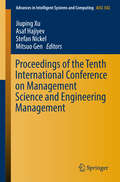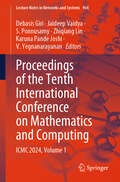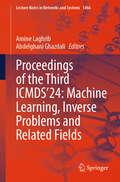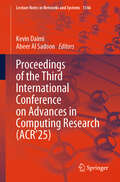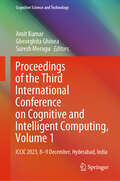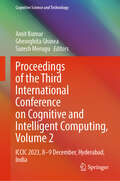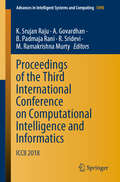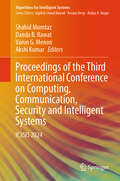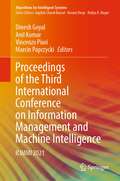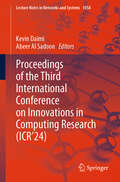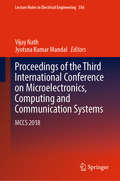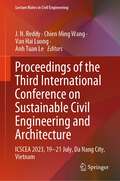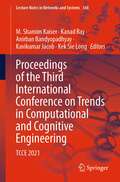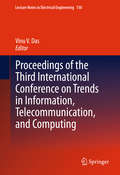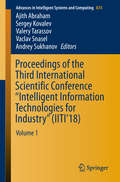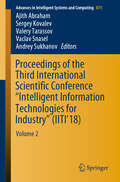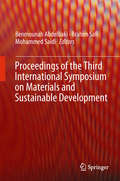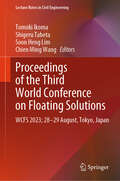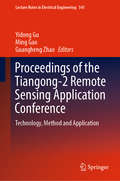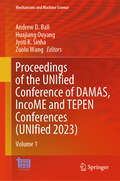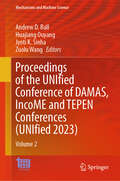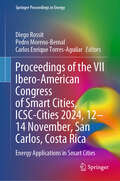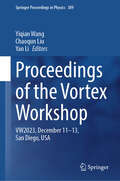- Table View
- List View
Proceedings of the Tenth International Conference on Management Science and Engineering Management
by Jiuping Xu Stefan Nickel Asaf Hajiyev Mitsuo GenThis book presents the proceedings of the Tenth International Conference on Management Science and Engineering Management (ICMSEM2016) held from August 30 to September 02, 2016 at Baku, Azerbaijan and organized by the International Society of Management Science and Engineering Management, Sichuan University (Chengdu, China) and Ministry of Education of Azerbaijan. The aim of conference was to foster international research collaborations in management science and engineering management as well as to provide a forum to present current research findings. The presented papers were selected and reviewed by the Program Committee, made up of respected experts in the area of management science and engineering management from around the globe. The contributions focus on identifying management science problems in engineering, innovatively using management theory and methods to solve engineering problems effectively and establishing novel management theories and methods to address new engineering management issues.
Proceedings of the Tenth International Conference on Mathematics and Computing: ICMC 2024, Volume 1 (Lecture Notes in Networks and Systems #964)
by S. Ponnusamy Debasis Giri Jaideep Vaidya Zhiqiang Lin Karuna Pande Joshi V. YegnanarayananThis book features selected papers from the 10th International Conference on Mathematics and Computing (ICMC 2024), held at Kalasalingam Academy of Research and Education (KARE), Krishnankoil, India during 2 – 7 January 2024. It covers recent advances in the field of mathematics, statistics, and scientific computing. The book presents innovative work by leading academics, researchers, and experts from industry in mathematics, statistics, cryptography, network security, cyber security, machine learning, data analytics and blockchain technology in computer science and information technology. The book is divided into two volumes.
Proceedings of the Tenth International Conference on Mathematics and Computing: ICMC 2024, Volume 2 (Lecture Notes in Networks and Systems #963)
by S. Ponnusamy Debasis Giri Jaideep Vaidya Zhiqiang Lin Karuna Pande Joshi V. YegnanarayananThis book features selected papers from the 10th International Conference on Mathematics and Computing (ICMC 2024), held at Kalasalingam Academy of Research and Education (KARE), Krishnankoil, India during 2 – 7 January 2024. It covers recent advances in the field of mathematics, statistics, and scientific computing. The book presents innovative work by leading academics, researchers, and experts from industry in mathematics, statistics, cryptography, network security, cyber security, machine learning, data analytics and blockchain technology in computer science and information technology. The book is divided into two volumes.
Proceedings of the Third ICMDS'24: Machine Learning, Inverse Problems and Related Fields (Lecture Notes in Networks and Systems #1466)
by Amine Laghrib Abdelghani GhazdaliThis book offers innovative insights into the integration of machine learning and inverse problems, showcasing cutting-edge methodologies that enhance computational efficiency and accuracy. By leveraging artificial intelligence, optimization techniques, and high-performance computing, it addresses complex challenges across various scientific and industrial domains. The contributions featured in this book encompass theoretical advancements and practical applications, highlighting diverse topics such as data-driven approaches, uncertainty quantification, and algorithmic innovations. This interdisciplinary collection is designed for researchers, practitioners, and students interested in the transformative potential of informatics and computational sciences. By presenting meticulously reviewed papers from the Third International Conference on Mathematical and Computational Sciences (ICMDS 2024), this issue serves as a valuable resource for fostering further research and development, inspiring new approaches to solving pressing problems through advanced computational methods.
Proceedings of the Third International Conference on Advances in Computing Research (Lecture Notes in Networks and Systems #1346)
by Kevin Daimi Abeer Al SadoonThis book concentrates on advances in research in the areas of computational intelligence, cybersecurity engineering, data analytics engineering, network and communications, cloud and mobile computing, software engineering, and robotics and automation. The Third International Conference on Advances in Computing Research (ACR&’25), July 7–9, 2025, Nice, France, brings together a diverse group of researchers from all over the world with the intent of fostering collaboration and dissemination of the advances in computing technologies. The conference is aptly segmented into six tracks to promote a birds-of-the-same-feather congregation and maximize participation. It introduces the concepts, techniques, methods, approaches, and trends needed by researchers, graduate students, specialists, and educators for keeping current and enhancing their research and knowledge in these areas.
Proceedings of the Third International Conference on Cognitive and Intelligent Computing, Volume 1: ICCIC 2023, 8-9 December, Hyderabad, India (Cognitive Science and Technology)
by Amit Kumar Suresh Merugu Gheorghita GhineaThis book presents original, peer-reviewed select articles from the International Conference on Cognitive and Intelligent Computing (ICCIC-2023), held on December 8–9, 2023, at Hyderabad, in India. The book focuses on the comprehensive nature of computational intelligence, cognitive computing, AI, ML, and DL in order to highlight its role in the modelling, identification, optimisation, prediction, forecasting, and control of future intelligent systems. It includes contributions from a methodological/application standpoint in understanding artificial intelligence and machine learning approaches and their capabilities in solving a wide range of problems in the real world.
Proceedings of the Third International Conference on Cognitive and Intelligent Computing, Volume 2: ICCIC 2023, 8-9 December, Hyderabad, India (Cognitive Science and Technology)
by Amit Kumar Suresh Merugu Gheorghita GhineaThis book presents original, peer-reviewed select articles from the International Conference on Cognitive and Intelligent Computing (ICCIC-2023), held on December 8–9, 2023, at Hyderabad, in India. The book focuses on the comprehensive nature of computational intelligence, cognitive computing, AI, ML, and DL in order to highlight its role in the modelling, identification, optimisation, prediction, forecasting, and control of future intelligent systems. It includes contributions from a methodological/application standpoint in understanding artificial intelligence and machine learning approaches and their capabilities in solving a wide range of problems in the real world.
Proceedings of the Third International Conference on Computational Intelligence and Informatics: ICCII 2018 (Advances in Intelligent Systems and Computing #1090)
by K. Srujan Raju B. Padmaja Rani A. Govardhan R. Sridevi M. Ramakrishna MurtyThis book features high-quality papers presented at the International Conference on Computational Intelligence and Informatics (ICCII 2018), which was held on 28–29 December 2018 at the Department of Computer Science and Engineering, JNTUH College of Engineering, Hyderabad, India. The papers focus on topics such as data mining, wireless sensor networks, parallel computing, image processing, network security, MANETS, natural language processing and Internet of things.
Proceedings of the Third International Conference on Computing, Communication, Security and Intelligent Systems: IC3SIS 2024 (Algorithms for Intelligent Systems)
by Danda B. Rawat Shahid Mumtaz Akshi Kumar Varun G. MenonThis book presents the best-selected research papers presented at the Third International Conference on Computing, Communication, Security & Intelligent Systems (IC3SIS 2024), organized by SCMS School of Engineering and Technology, Kochi, on July 11–12, 2024. It discusses the latest technologies in communication and intelligent systems, covering various areas of computing, such as advanced computing, communication and networking, intelligent systems and analytics, 5G and IoT, soft computing, and cybersecurity in general. Featuring work by leading researchers and technocrats, the book serves as a valuable reference resource for young researchers, academics, and industry practitioners.
Proceedings of the Third International Conference on Information Management and Machine Intelligence: ICIMMI 2021 (Algorithms for Intelligent Systems)
by Vincenzo Piuri Anil Kumar Marcin Paprzycki Dinesh GoyalThis book features selected papers presented at Third International Conference on International Conference on Information Management and Machine Intelligence (ICIMMI 2021) held at Poornima Institute of Engineering & Technology, Jaipur, Rajasthan, India during 23 – 24 December 2021. It covers a range of topics, including data analytics; AI; machine and deep learning; information management, security, processing techniques and interpretation; applications of artificial intelligence in soft computing and pattern recognition; cloud-based applications for machine learning; application of IoT in power distribution systems; as well as wireless sensor networks and adaptive wireless communication.
Proceedings of the Third International Conference on Innovations in Computing Research (Lecture Notes in Networks and Systems #1058)
by Kevin Daimi Abeer Al SadoonThe Third International Conference on Innovations in Computing Research (ICR’24), August 12–14, 2024, Athens, Greece, brings together a diverse group of researchers from all over the world with the intent of fostering collaboration and dissemination of the innovations in computing technologies. The conference is aptly segmented into six tracks to promote a birds-of-the-same-feather congregation and maximize participation. ICR’24 book concentrates on innovations in research in the areas of Data Science, Computer Science and Computer Engineering Education, Computer and Network Security, Health Informatics and Digital Imaging, Internet of Things, and Smart Cities and Smart Energy. It introduces the concepts, techniques, methods, approaches, and trends needed by researchers, graduate students, specialists, and educators for keeping current and enhancing their research and knowledge in these areas.
Proceedings of the Third International Conference on Microelectronics, Computing and Communication Systems: MCCS 2018 (Lecture Notes in Electrical Engineering #556)
by Jyotsna Kumar Mandal Vijay NathThe book presents high-quality papers from the Third International Conference on Microelectronics, Computing & Communication Systems (MCCS 2018). It discusses the latest technological trends and advances in MEMS and nanoelectronics, wireless communications, optical communication, instrumentation, signal processing, image processing, bioengineering, green energy, hybrid vehicles, environmental science, weather forecasting, cloud computing, renewable energy, RFID, CMOS sensors, actuators, transducers, telemetry systems, embedded systems, and sensor network applications. It includes papers based on original theoretical, practical and experimental simulations, development, applications, measurements, and testing. The applications and solutions discussed in the book provide excellent reference material for future product development.
Proceedings of the Third International Conference on Sustainable Civil Engineering and Architecture: ICSCEA 2023, 19–21 July, Da Nang City, Vietnam (Lecture Notes in Civil Engineering #442)
by J. N. Reddy Chien Ming Wang Van Hai Luong Anh Tuan LeThis book includes articles from the Third International Conference on Sustainable Civil Engineering and Architecture (ICSSEA 2023), held at Da Nang City, Vietnam, on July 19-21, 2023. The conference brings together international experts from both academia and industry to share their knowledge and expertise, facilitate collaboration, and improve cooperation in the field. The book focuses on the most recent developments in sustainable architecture and civil engineering, including offshore structures, structural engineering, building materials, and architecture.
Proceedings of the Third International Conference on Theoretical, Applied and Experimental Mechanics (Structural Integrity #16)
by Emmanuel Gdoutos Maria Konsta-GdoutosThis book presents the proceedings of the 3rd edition of the International Conference on Theoretical, Applied and Experimental Mechanics.The papers focus on all aspects of theoretical, applied and experimental mechanics, including biomechanics, composite materials, computational mechanics, constitutive modeling of materials, dynamics, elasticity, experimental mechanics, fracture mechanics, mechanical properties of materials, micromechanics, nanomechanics, plasticity, stress analysis, structures, wave propagation.
Proceedings of the Third International Conference on Trends in Computational and Cognitive Engineering: TCCE 2021 (Lecture Notes in Networks and Systems #348)
by Kanad Ray Anirban Bandyopadhyay M. Shamim Kaiser Kavikumar Jacob Kek Sie LongThis book presents various computational and cognitive modeling approaches in the areas of health, education, finance, environment, engineering, commerce, and industry. It is a collection of selected conference papers presented at the 3rd International Conference on Trends in Cognitive Computation Engineering (TCCE 2021), hosted online by Universiti Tun Hussein Onn Malaysia (UTHM) during October 21–22, 2021. It shares cutting-edge insights and ideas from mathematicians, engineers, scientists, and researchers and discusses fresh perspectives on problem solving in a range of research areas.
Proceedings of the Third International Conference on Trends in Information, Telecommunication and Computing
by Vinu V. DasThird International Conference on Recent Trends in Information, Telecommunication and Computing - ITC 2012. ITC 2012 will be held during Aug 03-04, 2012, Kochi, India. ITC 2012, is to bring together innovative academics and industrial experts in the field of Computer Science, Information Technology, Computational Engineering, and Communication to a common forum. The primary goal of the conference is to promote research and developmental activities in Computer Science, Information Technology, Computational Engineering, and Communication. Another goal is to promote scientific information interchange between researchers, developers, engineers, students, and practitioners.
Proceedings of the Third International Scientific Conference “Intelligent Information Technologies for Industry”: Volume 1 (Advances in Intelligent Systems and Computing #874)
by Ajith Abraham Vaclav Snasel Sergey Kovalev Valery Tarassov Andrey SukhanovThis book contains papers presented in the main track of IITI 2018, the Third International Scientific Conference on Intelligent Information Technologies for Industry held in Sochi, Russia on September 17–21. The conference was jointly co-organized by Rostov State Transport University (Russia) and VŠB – Technical University of Ostrava (Czech Republic) with the participation of Russian Association for Artificial Intelligence (RAAI). IITI 2018 was devoted to practical models and industrial applications related to intelligent information systems. It was considered as a meeting point for researchers and practitioners to enable the implementation of advanced information technologies into various industries. Nevertheless, some theoretical talks concerning the state-of-the-art in intelligent systems and soft computing were also included into proceedings.
Proceedings of the Third International Scientific Conference “Intelligent Information Technologies for Industry”: Volume 2 (Advances in Intelligent Systems and Computing #875)
by Ajith Abraham Vaclav Snasel Sergey Kovalev Valery Tarassov Andrey SukhanovThis book contains papers presented in the main track of IITI 2018, the Third International Scientific Conference on Intelligent Information Technologies for Industry held in Sochi, Russia on September 17–21. The conference was jointly co-organized by Rostov State Transport University (Russia) and VŠB – Technical University of Ostrava (Czech Republic) with the participation of Russian Association for Artificial Intelligence (RAAI). IITI 2018 was devoted to practical models and industrial applications related to intelligent information systems. It was considered as a meeting point for researchers and practitioners to enable the implementation of advanced information technologies into various industries. Nevertheless, some theoretical talks concerning the state-of-the-art in intelligent systems and soft computing were also included into proceedings.
Proceedings of the Third International Symposium on Materials and Sustainable Development
by Benmounah Abdelbaki Brahim Safi Mohammed SaidiThe third International Symposium on Materials and Sustainable Development ISMSD2017 (CIMDD2017) will include a 2-day Conferences (07 & 08 November). Organized by the Research Unit: Materials, Processes and Environment and University M'hamed Bougara of Boumerdes, this symposium follows the success of CIMDD 2013-2015 and continues the traditions of the highly successful series of International Conferences on the materials, processes and Environment. The Symposium will provide a unique topical forum to share the latest results of the materials and sustainable development research in Algeria and worldwide.
Proceedings of the Third World Conference on Floating Solutions: WCFS 2023; 28–29 August, Tokyo, Japan (Lecture Notes in Civil Engineering #465)
by Chien Ming Wang Soon Heng Lim Tomoki Ikoma Shigeru TabetaThis book includes peer-reviewed articles from the Third World Conference on Floating Solutions WCFS 2023 Japan with an aim to pioneer the SDGs and Next SDGs by making the most use of oceans and water. In recent years, the safety and security of people's lives around the world have been threatened by frequent floods and rising sea levels attributable to climate change. The COP 26 has set a common global goal of limiting the temperature rise to 1.5 degrees Celsius above pre-industrial levels. It is an urgent task to cope with climate change as well as to utilize decarbonized and renewable energy. The UN is promoting the SDGs which aim to achieve 17 Goals between 2015 and 2030. However, efforts to reach the Goals will not end in 2030 but will be an ongoing challenge for humanity beyond 2030. Here, we tentatively call the Goals to be achieved after the SDGs as "Next SDGs." Ocean and water have the potential to provide solutions to the disasters such as flooding and sea level rise due to climate change. In this context, WCFS 2023 presents ocean and water as the urban infrastructure and explores new technology and feasible solutions. In particular, it is necessary to consider urban planning, marine architecture, port planning connecting land and sea, disaster prevention, renewable energy, and food production on the sea and water. Further, it is indispensable that knowledge, experience, dream, and strong desire to realize these challenges are supported by a diversity of people.
Proceedings of the Tiangong-2 Remote Sensing Application Conference: Technology, Method and Application (Lecture Notes in Electrical Engineering #541)
by Yidong Gu Ming Gao Guangheng ZhaoThis book gathers a selection of peer-reviewed papers presented at the Tiangong-2 Data Utilization Conference, which was held in Beijing, China, in December 2018. As the first space laboratory in China, Tiangong-2 carries 3 new types of remote sensing payloads – the Wide-band Imaging Spectrometer (WIS), Three-dimensional Imaging Microwave Altimeter (TIMA), and Multi-band Ultraviolet Edge Imaging Spectrometer (MUEIS) – for observing the Earth. The spectrum of the WIS covers 18 bands, from visible to thermal infrared, with a swath of 300km. The TIMA is the first-ever system to use interferometric imaging radar altimeter (InIRA) technology to measure sea surface height and land topography at near-nadir angles with a wide swath. In turn, the MUEIS is the world’s first large-field atmospheric detector capable of quasi-synchronously detecting the characteristics of ultraviolet limb radiation in the middle atmosphere. The Earth observation data obtained by Tiangong-2 has attracted many research groups and been applied in such diverse areas as land resources, water resources, climate change, environmental monitoring, agriculture, forestry, ecology, oceanography, meteorology and so on. The main subjects considered in this proceedings volume include: payload design, data processing, data service and application. It also provides a comprehensive introduction to the research results gleaned by engineers, researchers and scientists throughout the lifecycle of the Tiangong-2 Earth observation data, which will improve the payload development and enhance remote sensing data applications.
Proceedings of the UNIfied Conference of DAMAS, IncoME and TEPEN Conferences: Volume 1 (Mechanisms and Machine Science #151)
by Jyoti K. Sinha Andrew D. Ball Huajiang Ouyang Zuolu WangThis volume gathers the latest advances, innovations and applications in the field of condition monitoring, damage assessment and maintenance engineering, as presented by leading international researchers and engineers at the UNIfied Conference of DAMAS (International Conference on Damage Assessment of Structures), IncoME (International Conference on Maintenance Engineering) and TEPEN (The Efficiency and Performance Engineering) Conferences, held in Huddersfield, UK on August 29 – September 1, 2023. Topics include machinery dynamics, sensors and measurement systems, signal processing, structural damage identification and machine fault diagnosis, plant maintenance and reliability, machine health monitoring, asset management, life-cycle cost optimisation, prognostics and health management, maintenance performance measurement, manufacturing process monitoring, and robot-based monitoring and diagnostics. The contributions, which were selected through a rigorous internationalpeer-review process, share exciting ideas that will spur novel research directions and foster new multidisciplinary collaborations.
Proceedings of the UNIfied Conference of DAMAS, IncoME and TEPEN Conferences: Volume 2 (Mechanisms and Machine Science #152)
by Jyoti K. Sinha Andrew D. Ball Huajiang Ouyang Zuolu WangThis volume gathers the latest advances, innovations and applications in the field of condition monitoring, damage assessment and maintenance engineering, as presented by leading international researchers and engineers at the UNIfied Conference of DAMAS (International Conference on Damage Assessment of Structures), IncoME (International Conference on Maintenance Engineering) and TEPEN (The Efficiency and Performance Engineering) Conferences, held in Huddersfield, UK on August 29 – September 1, 2023. Topics include machinery dynamics, sensors and measurement systems, signal processing, structural damage identification and machine fault diagnosis, plant maintenance and reliability, machine health monitoring, asset management, life-cycle cost optimisation, prognostics and health management, maintenance performance measurement, manufacturing process monitoring, and robot-based monitoring and diagnostics. The contributions, which were selected through a rigorous internationalpeer-review process, share exciting ideas that will spur novel research directions and foster new multidisciplinary collaborations.
Proceedings of the VII Ibero-American Congress of Smart Cities, ICSC-Cities 2024, 12–14 November, San Carlos, Costa Rica: Energy Applications in Smart Cities (Springer Proceedings in Energy)
by Diego Rossit Carlos Enrique Torres-Aguilar Pedro Moreno-BernalThis book compiles high-quality selected papers from the VII Ibero-American Congress of Smart Cities (ICSC-CITIES 2024), a leading event in the field of smart urban development. Smart cities are a response to the increasingly urgent need to reorient our lives towards sustainability. In an era of rapid urbanization and growing environmental challenges, these cities are designed to optimize resources, reduce environmental impact, and enhance the overall quality of life for their citizens. By leveraging advanced infrastructure, innovative solutions, and cutting-edge technology, smart cities aim to create more efficient, resilient, and livable urban environments. Within this framework, energy plays a pivotal role in enhancing the sustainability and functionality of our cities. The papers explore a wide range of topics, including smart grids, electric systems, energy efficiency, urban mobility, environmental monitoring, and other areas critical to the development of sustainable cities. The insights and research presented in this book contribute to the ongoing dialogue on how cities can better serve their populations while addressing the challenges of climate change, resource management, and technological integration. ICSC-CITIES 2024 takes place on November 12-14, 2024, in the vibrant city of San Carlos, Costa Rica, and is organized by Tecnológico de Costa Rica (TEC). As the eighth edition of the Ibero-American Congress of Smart Cities, this conference continues to be a key platform for academics, professionals, and policymakers to share knowledge, exchange ideas, and collaborate on the future of urban living. Authors invite the academic community and industry experts to engage in discussions and contribute to shaping the energy-related aspects and overall development of the cities of tomorrow.
Proceedings of the Vortex Workshop: VW2023, December 11-13, San Diego, USA (Springer Proceedings in Physics #254)
by Yan Li Chaoqun Liu Yiqian WangWritten by the leading experts in the field, this book results from Vortex Workshop 2023 which took place in San Diego, the USA, on December 11–13. Vortex is ubiquitous in the universe such as tornado, hurricane, airplane tip vortex, and even star vortex in Galaxy. Vortices are also building blocks, muscles, and sinews of turbulent flows. A vortex is intuitively recognized as a rotational/swirling motion of fluids but until recently had no rigidly mathematical definition. In 1858, Helmholtz first defined vortex as composed of so-called vortex filaments, which are infinitesimal vorticity tubes, which is called as the first generation of vortex definition and identification, or G1. Although G1 has been accepted by the fluid dynamics community and almost all textbooks for over a century, we can find many immediate counterexamples, for example, in the laminar boundary layer, where the vorticity (shear) is very large near the wall, but not rotation (no vortex) exists. To solve these contradictions, many vortex criteria methods have been developed during the past 4 decades. More popular methods are represented by the Q, ∆, criteria methods. These methods have achieved part of success in vortex identification, which are called the second generation of vortex identification or G2. However, G2 has several critical drawbacks. First, they are all scalars which have no rotation axis directions, but vortex is a vector. It is hard or impossible to use a scalar to represent a vector. Second, like vorticity, these criteria methods are all contaminated by shear in different degrees. Third, they are all very sensitive on threshold selections. The recently developed Liutex is called the third generation of vortex definition and identification, or G3, which is a uniquely defined vector.
